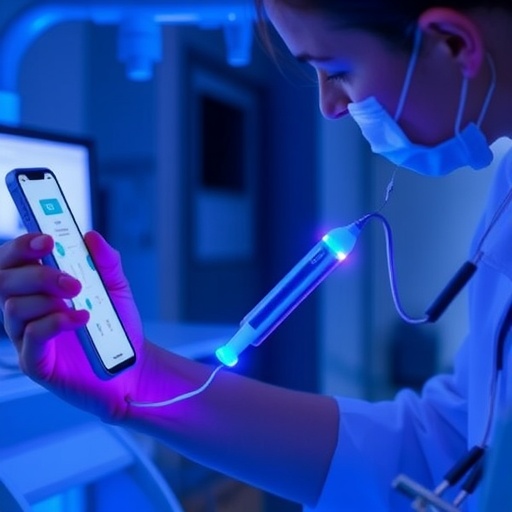In recent years, the field of women’s health has witnessed a revolutionary transformation driven by cutting-edge biomonitoring technologies. These advancements are not only enhancing our understanding of female physiology but are also empowering women to take proactive control over their health and well-being. The latest comprehensive review published in Nature Communications meticulously explores these technological strides, highlighting how innovations in biomonitoring are redefining diagnostics, prevention, and personalized medicine for women across various life stages.
Biomonitoring refers to the systematic measurement and analysis of biological markers—ranging from hormones and metabolites to genetic and epigenetic data—obtained through minimally invasive or non-invasive samples. For women’s health, such biomarkers serve as an invaluable window into intricate reproductive, metabolic, and endocrine processes uniquely characteristic of the female body. This paradigm shift from reactive treatment to anticipatory care hinges critically on continuous, real-time monitoring enabled by wearable devices, sensor platforms, and sophisticated analytical tools.
One of the most transformative arenas benefiting from these technologies is reproductive health, where the ability to accurately track hormonal fluctuations and ovulation cycles is vital. Contemporary biosensors employing microfluidics and nanoscale engineering allow for precise measurement of estrogen, progesterone, luteinizing hormone, and other fertility-related metrics through saliva, sweat, or menstrual fluid. These innovations facilitate personalized fertility planning and enhance diagnoses of disorders such as polycystic ovary syndrome (PCOS) or endometriosis, which have traditionally been challenging to detect early due to symptom variability and limited diagnostic tools.
Aside from reproductive hormones, biomonitoring extends into prenatal and postnatal care. Wearable monitoring systems now provide continuous surveillance of vital parameters in both expectant mothers and their fetuses, detecting early warning signs of complications like preeclampsia or fetal distress. These devices harness advanced biosensing modalities coupled with telemetry to transmit real-time data to healthcare providers, ensuring prompt medical interventions that can substantially improve maternal and neonatal outcomes.
Moreover, the integration of machine learning algorithms and big data analytics with biomonitoring enhances the predictive power of collected biological data. Aggregating biomarker profiles over time enables the identification of subtle patterns linked to chronic conditions disproportionately affecting women, such as osteoporosis, cardiovascular diseases, and autoimmune disorders. This longitudinal data facilitates the tailoring of individualized treatment strategies that consider a woman’s unique physiological, genetic, and environmental context.
The rise of mobile health (mHealth) applications designed for women’s wellness also complements biomonitoring initiatives. These platforms transform raw health data into actionable insights, supporting behaviors conducive to optimal health such as nutritional adjustments, physical activity regimens, and stress management techniques. By bridging gaps between clinical care and everyday health practices, mHealth empowers users to take ownership of their health trajectory with unprecedented ease.
Technological advances in sampling techniques represent another pivotal aspect of recent progress. Non-invasive methods leveraging sweat and interstitial fluid, in conjunction with biosensors embedded in skin patches or smart textiles, circumvent the need for frequent blood draws, historically a barrier to widespread biomonitoring adoption. This approach minimizes discomfort, reduces infection risk, and fosters compliance, amplifying the potential for continuous health surveillance in diverse populations.
The expanding landscape of biomonitoring technologies further embraces the field of metabolomics, which elucidates the biochemical fingerprints reflective of physiological states. High-resolution mass spectrometry systems integrated into portable devices now permit detailed metabolic profiling in routine settings, enabling early detection of metabolic syndromes and adjusting therapeutic regimens specific to female metabolic dynamics.
An equally critical development lies in the growing focus on mental health biomarkers relevant to women. Bioelectrical signals, cortisol concentrations, and neurotransmitter metabolites are now measurable with emerging technologies, offering objective correlates for conditions ranging from postpartum depression to anxiety disorders with higher prevalence in women. Such data enrich the holistic understanding of female health, fostering integrated approaches that encompass both physical and psychological dimensions.
The confluence of genetic and epigenetic biomonitoring tools informs the trajectories of diseases linked to hereditary and environmental factors. Advances in minimally invasive sampling for nucleic acids enable real-time detection of genetic mutations, methylation patterns, and gene expression profiles critical to conditions like breast and ovarian cancers. Early identification at the molecular level opens avenues for preemptive interventions, significantly improving prognosis.
Importantly, the development of these technologies has been conscientious about addressing health equity and accessibility challenges. Researchers emphasize designing low-cost, user-friendly devices tailored to diverse socioeconomic settings, thereby democratizing access to personalized health monitoring. This inclusivity is foundational to ensuring that the benefits of biomonitoring reach all women, transcending geographical and cultural barriers.
The ethical implications surrounding personal biomonitoring data, including privacy, consent, and data security, have prompted rigorous discourse within the scientific and regulatory communities. Robust frameworks are emerging to safeguard sensitive information while promoting interoperability among healthcare systems, fostering seamless yet secure integration of biomonitoring data into clinical decision-making processes.
The ongoing collaboration between engineers, biologists, clinicians, and data scientists fuels the iterative refinement of biomonitoring platforms. Multidisciplinary initiatives are exploring next-generation biosensors that combine multiplexed analyte detection, nanomaterials innovations, and artificial intelligence-driven diagnostics, propelling the field toward increasingly precise and holistic women’s health solutions.
As the frontier of biomonitoring technologies expands, integrating these advances holds transformative potential not only for individual health outcomes but also for public health paradigms. Population-scale data generated through widespread adoption can illuminate epidemiological trends and inform policy interventions tailored to female health challenges on a global scale.
Looking ahead, the convergence of biomonitoring with emerging disciplines such as microbiomics and bioinformatics promises richer insights into the complex interactions between genetic, environmental, and lifestyle factors influencing women’s health. These integrative approaches may profoundly recalibrate preventive medicine, personalizing care pathways and enhancing quality of life for millions.
In essence, the continuous innovation in biomonitoring technologies heralds a new era in women’s health—one characterized by precision, personalization, and proactive engagement. The momentum witnessed in recent years signals a paradigm shift poised to redefine how women monitor, manage, and ultimately optimize their health across the lifespan, driven by technology that is at once sophisticated and accessible.
Subject of Research: Advances in biomonitoring technologies aimed at improving women’s health diagnostics, monitoring, and personalized treatment strategies.
Article Title: Advances in biomonitoring technologies for women’s health.
Article References:
Moghimikandelousi, S., Najm, L., Lee, Y. et al. Advances in biomonitoring technologies for women’s health. Nat Commun 16, 8507 (2025). https://doi.org/10.1038/s41467-025-63501-3
Image Credits: AI Generated
Tags: advancements in reproductive health diagnosticsbiomarkers in female physiologybiomonitoring technologies for women’s healthcomprehensive review of biomonitoring in healthhormonal tracking and ovulation cyclesinnovations in fertility monitoring technologiesnon-invasive health monitoring solutionspersonalized medicine for womenpreventive health strategies for womenreal-time health data analysistransformative health technologies for womenwearable devices for health monitoring





